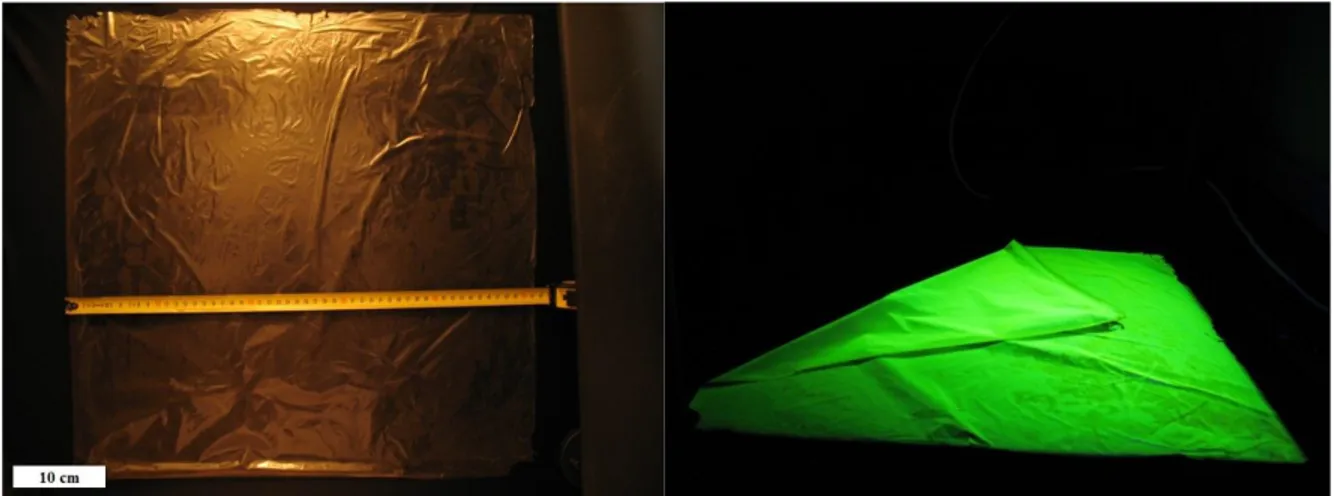Large-area (> 50 cm
50 cm), freestanding, flexible, optical
membranes of Cd-free nanocrystal quantum dots
Evren Mutlugun,1,2 Pedro Ludwig Hernandez Martinez,1,2 Cuneyt Eroglu,1 Yasemin Coskun,1 Talha Erdem,1 Vijay K. Sharma,1 Emre Unal,1 Subhendu K. Panda,3 Stephen G. Hickey,3 Nikolai Gaponik,
Alexander Eychmüller,3 and Hilmi Volkan Demir1,2*
1 Department of Physics, Department of Electrical and Electronics Engineering, and UNAM - Institute of Materials Science and Nanotechnology,
Bilkent University, TR-06800, Ankara, Turkey
2 Luminous! Center of Excellence for Semiconductor Lighting and Displays, School of Electrical and Electronic Engineering, Division of
Microelectronics, School of Mathematical and Physical Sciences, Nanyang Technological University, Nanyang Avenue, Singapore 639798, Singapore
3 Physical Chemistry/Electrochemistry, TU Dresden, Bergstr. 66b, 01062 Dresden, Germany
*Tel:[+90]( 312) 2901021, e-mail: volkan@stanfordalumni.org
Colloidal semiconductor quantum dots (QDs) have been extensively explored for numerous applications ranging from optoelectronics to biotechnology. This strong demand for the colloidal QDs arises because of their favorable optical and electronic properties. From the application points of view, QDs typically need to be used in their solid form, as opposed to their as-synthesized dispersion form. For immobilization of QDs and homogeneity of their films, various polymers have been used to host QDs within solid media. However, the integration of QDs into a polymeric medium is commonly complex, which requires a high level of understanding to provide optical quality. Such QD films should preferably be flexible and freestanding, and exhibit high optical quality to employ QDs in various device platforms. Additionally, considering extensive ongoing research efforts on large-area electronics and optoelectronics, the standalone QD films should desirably be fabricated over large areas for high-end applications. To date several research works have reported QD-polymeric films in sizes of few cm × few cm [1-3]. While these reports have successfully demonstrated flexible and/or standalone Cd-based QD membranes, there has been no report on the demonstration of a large-area QD-polymer composite membrane to date. Such large-area standalone films have thus far been not shown for Cd-containing or Cd-free QDs.
Here, we report on the first account of standalone, flexible films of Cd-free InP/ZnS QDs-polymer composites fabricated over very large areas (over 50 cm × 50 cm). Fig. 1 demonstrates the macroscopic image of QD-PMMA composite films that opportunely utilize fatty acids as the ligands to make free-standing membranes in a size of 51 cm × 51 cm under room light and UV excitation [4]. The fabrication of these QD polymeric films and the formation of their standalone composite membranes have been made possible by the fatty acid ligands used in the colloidal synthesis, which has successfully provided easy peeling of the thin film on the glass substrate. This is due to the hydrophobic behavior observed with the use of fatty acid ligands in the QD synthesis. Contact angle measurements show that the resulting films become substantially hydrophobic upon forming composite structures with InP/ZnS QDs. These films show high optical quality, with a homogenous distribution of QDs across the optical membrane. In the composite membrane, the temperature-dependent emission kinetics and energy transfer dynamics among different sized InP/ZnS QDs were also investigated. High levels of energy transfer efficiency (up to 80%) and strong donor lifetime modification (from 18 to 4 ns) are observed. The nonradiative channels are suppressed when the hybrid membrane is cooled to cryogenic temperatures. The lifetime changes of the donor and acceptor InP/ZnS QDs in the membrane as a result of the energy transfer are explained by our theoretical model based on the exciton-exciton interactions among the dots and found in excellent agreement with the experimental results.
Furthermore, as a device application, we employed flexible optical membranes of these QDs as remote nanophosphor color convertors for the demonstration of superior-quality white LEDs. Using standalone green- and red-emitting QD polymeric bilayer films on blue LED platforms, our white LED demonstrates a high color-rendering index (CRI) of 89.30 with a warm correlated color temperature (CCT) of 2,298 K and a large luminous
efficacy of optical radiation (LER) of 253.98 lm/Wopt, producing high photometric performance. (Fig. 2)
477
WH1 (Contributed Oral) 8:30 AM – 8:45 AM
In conclusion, we fabricated very large-area standalone films of environmentally friendly nanocrystal QDs and demonstrated color conversion white LED application using flexible bilayer structures. These results are believed to potentially open new possibilities towards large-area optoelectronics of detoxified QDs.
Acknowledgements: This work is supported in part by NRF-CRP-6-2010-02 and NRF-RF-2009-09, and in part by EU-FP7 Nanophotonics4Energy NoE, BMBF TUR 09/001, and TUBITAK EEEAG, 109E002, 109E004, 110E010, and 110E217. H.V.D. acknowledges support from ESF-EURYI, TUBA-GEBIP; and E.M. from TUBITAK BIDEB. S.K.P. is grateful for a research fellowship provided by the Alexander von Humboldt Foundation.
References
[1] H. Zhang, et al. Adv. Mater., 17, 853-857 (2005). [2] M. C. Neves, et al. Nanotechnology, 19, 155601 (2008). [3] H. Tetsuka, et al. Adv. Mater., 20, 3039–3043 (2008). [4] E. Mutlugun, et al. (2012) (submitted).
Figure 1. Photograph of a 51 cm × 51 cm InP/ZnS QD membrane under room light along with a ruler (left) and the folded membrane under UV illumination (right).
Figure 2. Electroluminescence spectra of white LED using InP/ZnS QDs as wavelength upconverting remote nanophosphors with a blue LED chip (left). An exemplary device under operation (right).
